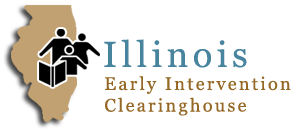In the early intervention (EI) program, the family, service coordinator, and EI professionals are a team. When an EI team gathers, the conversation often involves talking about outcomes. In early intervention, we use the word outcomes to describe what family members want to see happen for their child and their family as a result of their participation in the EI program. These outcomes are listed in the individual family service plan (IFSP). This plan identifies the family’s concerns and priorities for meeting their child’s needs.
Making progress toward outcomes is the result of the many small and big steps the family and EI service providers take as they work together. EI team members need to help each other understand the family’s routine so they can choose and use strategies that work well for the family. Let’s consider an example of how an EI team can work together to plan strategies for a toddler to reach an IFSP outcome related to communication.
Lucy is 24 months old. She receives EI services for a delay in language development. When Lucy’s family and their EI team meet to write her IFSP, they decide one overall outcome they want to work toward is encouraging Lucy to give a verbal response when she normally would point or nod. The team talks about times during everyday routines that Lucy’s family could encourage her to use words and build her vocabulary.
Lucy’s family loves to play outside. The team decides to have a speech therapy session at the playground to develop strategies to encourage Lucy to use her words. The speech therapist and her family practice ways to encourage Lucy to respond with words and increase Lucy’s vocabulary. Now, when Lucy gets to the bottom of the slide, her dad says, “That was fun! The slide is slippery and fast. Do you want to slide again?” He waits, and then if Lucy responds by shrieking with delight, he says, “You are excited! Tell me ‘yes’ if you want to slide again.” “Ess!” says Lucy.
Every park playtime becomes an opportunity to work toward the outcome of improving Lucy’s language skills. By encouraging Lucy to use more words and continuing to use descriptive words himself, Lucy’s dad helps her take more and more steps toward their outcome of using her words to communicate.
Focusing on daily routines is how EI teams meet IFSP outcomes. This EI Clearinghouse newsletter contains resources you can use to support language development at home, understand who is on your EI team, and work together toward outcomes. With every little step, an EI team gets closer to achieving IFSP outcomes as well as building a strong foundation for future growth.
- Tip Sheets: Who Is on Your Early Intervention Team?
- Resource Guides: Supporting Language Development at Home

